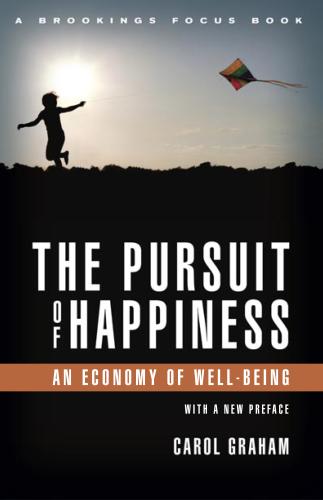This report is part of a series of essays by the Global Economy and Development program—a 10th anniversary edition. The series, available here, delves into the critical issues facing all those concerned about globalization. You can join the conversation on Twitter using #11GlobalDebates.
1.1 What’s the issue?
Today, standard benchmarks of progress, productivity, job quality, and democracy are being upended. Income-based measures such as gross domestic product (GDP) served us well for decades, yet when GDP counts pollutant-generating economic activity on the positive side of the balance sheet, or when it fails to measure unpaid labor activity, it falls short. This is especially worrying given that we live in a world wracked by social inequities.
162—the number of countries Gallup has surveyed annually worldwide since 2005
As David Rothkopf pointed out in The New York Times in 2011, the early authors of these metrics, including economist Simon Kuznets, warned about these shortcomings, cautioning that a nation’s welfare cannot be “inferred from (such) a measurement of national income.” Regardless, GDP became the established marker of macroeconomic success worldwide.
1.2 What’s the debate?
Experts are realizing that GDP is not a sufficient tool for measuring prosperity and well-being and that, since people rarely behave as “rational actors,” we may need to give subjective well-being measures more due. With rapid technological change, key variables in GDP like cars and factories are over-weighted, while cell phones and green technologies are under-weighted. Subjective well-being metrics assess how people experience their daily lives on the one hand, and how they evaluate their lives as a whole on the other. Included in a range of surveys–from the Gallup World Poll to the official statistics of countries such as United Kingdom and Canada—the metrics allow us to gauge the welfare effects of phenomena other measures do not easily capture. These phenomena include situations that individuals cannot change, such as bad governance or inequality, as well as behaviors driven by addiction and self-control problems—such as smoking or obesity—or situations when poor people do not have the capacity to exercise choice.
Much public attention goes to cross-country comparisons of average levels of happiness and how particular countries rank on a world happiness index. Yet country averages tell us much less than individual level data, and the scores also change much less than trends across cohorts within countries. Country averages also pick up country specific traits–such as cultural differences in the way that people answer survey questions and/or innate cheerfulness or pessimism.
Still, more broadly, factors such as average levels of GDP per capita, freedom to make choices in life, health status, social capital, and the absence of corruption vary across countries; those that score better, on average, also score higher on average levels of life satisfaction. As such, wealthy countries in general score higher globally, and very poor countries (particularly those with high levels of violence) are routinely at the bottom of the rankings, as seen in Figure 1.
The Gallup Poll, which has surveyed 162 countries annually since 2005, and includes a wide range of subjective well-being metrics, yields many novel insights. For example, the difference between the poor and the rich in beliefs that hard work will get individuals ahead in the United States is twice as large as that between the poor and the rich in Latin America; in other words, the poor in Latin America are significantly more optimistic that their efforts will pay off in terms of future mobility. Insights like these can inform social support and tax policies in vital ways.

Yet big differences exist between some countries’ GDP per capita and life satisfaction rankings; these are due on the one hand to a mix of objective quality of life indicators and on the other to innate character traits and cultural differences. Latin American countries, for example, typically score higher than their incomes would predict, while Eastern European ones score lower. Quality of life is better on many fronts in Latin America than in Eastern Europe, and Latin Americans score much higher on measures of natural cheerfulness and positive affect. And while the averages and the rankings do not move much in general, they move in the expected direction in the face of financial and other crises (down), and when things like democracy and safety improve (up). The countries that experienced the greatest average drops in life satisfaction between 2005 and 2007 and from 2012 to 2014, for example, were Greece, Egypt, and Italy.
17.8% is how much more likely poor whites in the the U.S. are to be stressed and pessimistic on a given day in comparison to middle-class white Americans.
1.3 What to watch out for?
Subjective measures of well-being also reveal a “paradox of unhappy growth,” whereby life satisfaction levels often fall dramatically during periods of very rapid growth, due to insecurity, inequality, and changing rewards to different skill sets. While life satisfaction levels usually recover over time, the human costs in the interim can be very high, as evinced with the rise in suicide and mental illness rates in China from 1995 to 2010.
Extensive research based on hundreds of thousands of individuals across countries and over time reveals consistent patterns in the determinants of life satisfaction globally, with factors such as sufficient income, good health, stable partnerships, stable employment, and freedom all playing important roles. Women are typically happier than men, except in places where gender rights are severely compromised. There is also a remarkably consistent U-shaped relationship between age and life satisfaction, with the least happy years coinciding with the middle-aged years in most countries around the world. The turn upward occurs earlier in places with higher average levels of well-being, with the average being 48 years in the happier countries and 62 years in the least happy countries. As such, individuals in happier places have, on average, 14 more happy life years. Stress levels, meanwhile, display a similar age trend, but with an upside down U shape, with middle-aged people experiencing more stress than those who are much younger or much older.
As for the well-being effects of information technology, the overall effects on life satisfaction are positive, particularly where they increase capabilities, but the technologies are also associated with higher levels of stress and anger for the same respondents.
Also revealing is the value of “flex time” and/or voluntary parttime work status. While both are likely to be associated with lower wages, they are also associated with significantly higher levels of well-being in Organization for Economic Cooperation and Development countries. Having autonomy at work does not have an attached income value, but the assessed value in terms of well-being is very high relative to that of higher marginal incomes. Volunteering, meanwhile, also has significant benefits in terms of well-being. All of these factors are important as we reassess benchmarks of progress and productivity at a time when the nature of stable, middle-class jobs is changing in many countries.
Subjective well-being metrics can also attach value (in relative terms) to the effects of differential environmental conditions, ranging from airplane noise to air pollution. The same metrics can be applied to assess relative values to commuting time, diversity in cities, local and national level inequality, and more.
14 — The number of happy life years gained when you live in a country with a higher well-being ranking
People with higher levels of well-being are more productive, healthy, and more likely to invest in their futures. Conversely, the metrics show the high well-being costs of lacking faith in the future, such as deep desperation and even increasing suicide rates among the left-behinds. For example, stress and pessimism are especially high among poor whites in the U.S. My research with Sergio Pinto, Ph.D. student at the University of Maryland, exploring differential levels of optimism and stress by race and socioeconomic categories in the Gallup data, finds that poor whites are 17.8 percent more likely to be stressed and pessimistic on a given day in comparison to their middle-class white counterparts.
Those who are unable to take advantage of changing trends because of lack of skills and education or the inability to plan beyond the moment are falling further behind and facing competition from new competitors for low-skilled jobs. Fear of downward mobility among some of them, meanwhile, is reflected in rising levels of support for extremist politicians in many countries, including in Europe and the U.S.
1.4 What’s Next?
Subjective well-being measures offer a first step toward better gauging social ills. Had the metrics been a part of official statistics in China during the high growth period, for example, public awareness of the sharp increases in unhappiness and mental illness might have helped avert some of the highest costs, such as increases in suicides. And had official statistics in the U.S. included well-being trends in recent years, experts might not have been caught off guard by rising mortality rates among downwardly mobile groups and the related rise of extremist politics. Precisely because subjective well-being metrics do not always tell the same story as GDP and other incomebased metrics, as in the case of the “paradox of unhappy growth,” they provide policymakers with an important new tool for assessing the state of their societies’ well-being in the face of economic and other changes.






